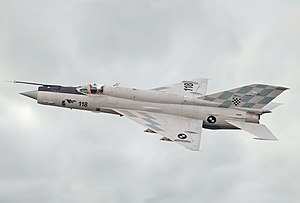| MiG-21 | |
|---|---|
 Croatian MiG-21BIS-D in flight | |
| General information | |
| Type | Fighter and interceptor aircraft |
| National origin | Soviet Union |
| Designer | Mikoyan-Gurevich |
| Status | In service |
| Primary users | Soviet Air Forces (historical) |
| Number built | 11,496[1] (10,645 produced in the USSR, 840 in India, 194 in Czechoslovakia) |
| History | |
| Manufactured | 1959–1986 |
| Introduction date | 1959 (MiG-21F) |
| First flight | 16 June 1955 (Ye-4)[citation needed] |
| Variants | Chengdu J-7 |
The Mikoyan-Gurevich MiG-21 (Russian: Микоян и Гуревич МиГ-21; NATO reporting name: Fishbed) is a supersonic jet fighter and interceptor aircraft, designed by the Mikoyan-Gurevich Design Bureau in the Soviet Union. Its nicknames include: "Balalaika", because its planform resembles the stringed musical instrument of the same name; "Ołówek", Polish for "pencil", due to the shape of its fuselage,[2] and "Én Bạc", meaning "silver swallow", in Vietnamese.
Approximately 60 countries across four continents have flown the MiG-21, and it still serves many nations seven decades after its maiden flight. It set aviation records, becoming the most-produced supersonic jet aircraft in aviation history, the most-produced combat aircraft since the Korean War and, previously, the longest production run of any combat aircraft.
- ^ Gordon, Yefim. MiG-21 (Russian Fighters). Earl Shilton, Leicester, UK: Midland Publishing Ltd., 2008. ISBN 978-1-85780-257-3.
- ^ "MiG-21 – naddźwiękowy ołówek" (in Polish). Archived 6 June 2011 at the Wayback Machine lotniczapolska.pl, 6 September 2007. Retrieved: 1 December 2010.